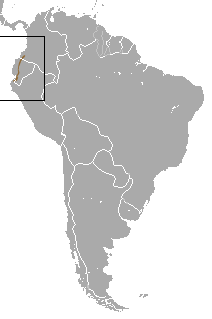Little woolly mouse opossum
| Little woolly mouse opossum | |
|---|---|
| Scientific classification | |
| Kingdom: | |
| Phylum: | |
| Class: | |
| Infraclass: | |
| Order: | |
| Family: | |
| Genus: | |
| Subgenus: | |
| Species: | M. phaea
|
| Binomial name | |
| Marmosa phaea (Thomas, 1899)
| |

| |
| Little woolly mouse opossum range | |
| Synonyms | |
|
Micoureus phaeus (Thomas, 1899) | |
The little woolly mouse opossum (Marmosa phaea) is a nocturnal, arboreal and mainly solitary South American marsupial of the family Didelphidae.[2] It is native to the western slopes of the Andes in Colombia, Ecuador and Peru, where it lives at altitudes from sea level to 1500 m.[1] It primarily inhabits lowland rainforest and montane cloud forest, although it has been reported from dry forest in the southern end of its range.[1] It was formerly assigned to the genus Micoureus, which was made a subgenus of Marmosa in 2009.[3] Its conservation status is Vulnerable, due to habitat fragmentation and continuing loss of habitat via urbanization and conversion to agriculture.[1]
References
- ^ a b c d "Marmosa phaea". IUCN Red List of Threatened Species. 2015. IUCN: e.T136244A22175055. 2015. doi:10.2305/IUCN.UK.2015-4.RLTS.T136244A22175055.en. Retrieved 4 November 2016.
{{cite journal}}: Cite uses deprecated parameter|authors=(help) - ^ Gardner, A.L. (2005). "Order Didelphimorphia". In Wilson, D.E.; Reeder, D.M (eds.). Mammal Species of the World: A Taxonomic and Geographic Reference (3rd ed.). Johns Hopkins University Press. p. 13. ISBN 978-0-8018-8221-0. OCLC 62265494.
- ^ Voss, R. S.; Jansa, S. A. (2009). "Phylogenetic relationships and classification of didelphid marsupials, an extant radiation of New World metatherian mammals". Bulletin of the American Museum of Natural History. 322: 1–177. doi:10.1206/322.1. Retrieved 2012-01-18.

